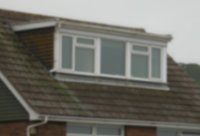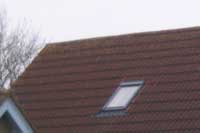Loft conversion - using your roof space
A loft conversion by using roof space is often a very convenient and relatively inexpensive way to increase living space. Loft conversions normally add more value to a property than they cost so are very cost effective. Before deciding if it is a practical idea a few aspects need to be considered.
This page is based on current (2004) Building regulations but is not exhaustive and reference to your local building control office is essential before commencing any work. The basic things to think about are:
-
Does the roof void give adequate height and room ? Usually a height of 2.4m is required under the roof ridge (the highest point), although with careful design, you may get away with 2.1m. There are two basic types of roof construction, rafters (the traditional, built on site method) or trusses (pre-built in a workshop and transported to site) popular since the 1970's. Roof rafters normally leave the centre of the roof void fairly open, whereas the standard design of roof trusses obstructs the space. Where standard roof trusses are used, a fair amount of strengthening will be required so that parts of the trusses can be cut away to open up the roof space - roof trusses must never be modified without professional guidance. Installing dormer windows can extend the area of maximum height but at a financial cost (see windows below). If the property is detached, there may be an option to consider replacing the entire roof, while this may sound drastic, a change in the design of the roof structure may produce a far better room than trying to design one around the existing roof.

 <
<

- Are the joists in the roof void strong enough for a floor ? Generally the joists in the roof are not designed to take a floor (often 4" x 2"), so you'll probably need to install new joists (6" x 2" or 8" x 2").
- Can a suitable permanent stairway be made to the roof space ? For a loft conversion to be deemed inhabitable rooms, a permanent stairway of suitable size, vertical clearance and angle is required - spiral staircases may be an option but make carrying furniture up almost impossible. Fitting a loft ladder is not the answer, it will cause the rooms in the roof to be 'not inhabitable.
- Can suitable windows be made in the roof ? The choices are roof lights (installed
flat to the roof) or dormer windows.
 Dormer window
Dormer window
 Roof light
Roof light
Careful use of dormers in a design can increase the area of useful height. The position of dormers may be restricted by the planning authority, they sometime won't allow them on the front or side of the property (as these will change the appearance from the road) but will allow them on the back. Where the loft has a gable end, a window can sometimes be inserted in the gable wall. - Is the property detached ? If not, you'll probably need to obtain a party wall agreement with your neighbour(s). A party wall agreement controls the use of walls, ceilings or floors shared by neighbouring property. Get the agreement signed before work starts.
- Can suitable escape routes be provided ? Windows must be provided to give a method of escape in the event of a fire, the opening needs to be unrestricted 45cm x 45cm, it must also be positioned so that it can be reached.
- If you are adding a bathroom or toilet to the roof void, how convenience are the water and waste services ? The main problem will probably be running the waste pipe from the toilet, where installing a full size waste pipe is impractical, an option may be to use a toilet with a macerator and small bore waste pipe.
- Is the loft above the second storey ? This makes the conversion more complicated
as certain additional planning regulations relating to fire precautions apply, these include:
- The stairs must enter the main stair well on the second floor, an alternative is to provide an external method of escape.
- The floor of the loft conversion must provide at least a half hour fire barrier.
All doors on the ground and first floor must have self closers, any new doors must be half hour fire doors. - Mains powered interlinked, fire/smoke detectors must be fitted on each floor.
Even if you intend to carry out the loft conversion yourself, you should always consult a structural engineer and the local building control department before starting work and before cutting any part of the roof structure. If you fail to meet all the building regulations applicable, you could have problems and could find it hard when you come to sell the house as the room may not be deemed inhabitable and suddenly you could find that your three bedroom house becomes two bedrooms with roof storage.
Depending upon the size of the roof void you intend to convert, you may need planning permission - you'll also need it if you live in a conservation area or if the property is listed - it is always better to check with the local Planning Authority before starting any work.
